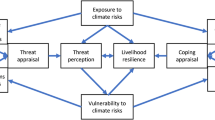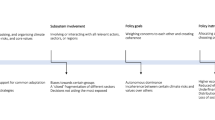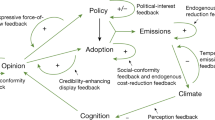Abstract
Sustainable economic development and resilience to climate change impacts require human adaptation to a warming climate. It is possible that rising costs of climate change will provide incentives to increase adaptation actions in the future. This Perspective argues, by contrast, that adaptation to the costs of global warming is likely to be ineffective. Empirical evidence suggests that current adaptations are generally limited, and climate change is likely to undermine adaptive capacity, making intensification of the costs of warming as likely as adaptation to them. Climate adaptation will require difficult political action and is not an inevitable consequence of climate damages.
This is a preview of subscription content, access via your institution
Access options
Access Nature and 54 other Nature Portfolio journals
Get Nature+, our best-value online-access subscription
$32.99 / 30 days
cancel any time
Subscribe to this journal
Receive 12 digital issues and online access to articles
$119.00 per year
only $9.92 per issue
Buy this article
- Purchase on SpringerLink
- Instant access to full article PDF
Prices may be subject to local taxes which are calculated during checkout


Similar content being viewed by others
References
Carleton, T. A. & Hsiang, S. M. Social and economic impacts of climate. Science 353, aad9837 (2016).
GAR Special Report 2023: Mapping Resilience for the Sustainable Development Goals (UNDRR, 2023).
Moller, V. et al. in Climate Change 2022: Impacts, Adaptation and Vulnerability (eds Pörtner, H.-O. et al.) 2897–2930 (Cambridge Univ. Press, 2022).
Berrang-Ford, L. et al. A systematic global stocktake of evidence on human adaptation to climate change. Nat. Clim. Change 11, 989–1000 (2021).
O’Neill, B. C. et al. in Climate Change 2022: Impacts, Adaptation and Vulnerability (eds Pörtner, H.-O. et al.) 2411–2538 (Cambridge Univ. Press, 2022).
Dell, M., Jones, B. F. & Olken, B. A. What do we learn from the weather? The new climate–economy literature. J. Econ. Literature 52, 740–798 (2014).
Hsiang, S. Climate econometrics. Annu. Rev. Res. Econ. 8, 43–75 (2016).
Barreca, A., Clay, K., Deschenes, O., Greenstone, M. & Shapiro, J. S. Adapting to climate change: the remarkable decline in the US temperature–mortality relationship over the twentieth century. J. Polit. Econ. 124, 105–159 (2016).
Carleton, T. et al. Valuing the global mortality consequences of climate change accounting for adaptation costs and benefits. Q. J. Econ. 137, 2037–2105 (2022).
Schlenker, W. & Roberts, M. J. Nonlinear temperature effects indicate severe damages to US crop yields under climate change. Proc. Natl Acad. Sci. USA 106, 15594–15598 (2009).
Callahan, C. W. & Mankin, J. S. Globally unequal effect of extreme heat on economic growth. Sci. Adv. 8, eadd3726 (2022).
Hsiang, S. M. & Jina, A. S. The Causal Effect of Environmental Catastrophe on Long-Run Economic Growth: Evidence from 6,700 Cyclones (NBER, 2014).
Callahan, C. W. & Mankin, J. S. Persistent effect of El Niño on global economic growth. Science 380, 1064–1069 (2023).
Kotz, M., Levermann, A. & Wenz, L. The effect of rainfall changes on economic production. Nature 601, 223–227 (2022).
Burke, M., Hsiang, S. M. & Miguel, E. Global non-linear effect of temperature on economic production. Nature 527, 235–239 (2015).
Rode, A. et al. Estimating a social cost of carbon for global energy consumption. Nature 598, 308–314 (2021).
Moore, F. C. & Diaz, D. B. Temperature impacts on economic growth warrant stringent mitigation policy. Nat. Clim. Change 5, 127 (2015).
Deryugina, T. & Hsiang, S. The Marginal Product of Climate (NBER, 2017).
Schelling, T. C. Anticipating climate change: implications for welfare and policy. Environ. Sci. Policy Sustain. Dev. 26, 6–35 (1984).
Schelling, T. C. Some economics of global warming. Am. Econ. Rev. 82, 1–14 (1992).
Diaz, D. & Moore, F. Quantifying the economic risks of climate change. Nat. Clim. Change 7, 774–782 (2017).
Cruz, J.-L. & Rossi-Hansberg, E. The economic geography of global warming. Rev. Econ. Stud. 91, 899–939 (2024).
Kahn, M. E. Adapting to Climate Change: Markets and the Management of an Uncertain Future (Yale University Press, 2021).
Ara Begum, R. et al. in Climate Change 2022: Impacts, Adaptation and Vulnerability (eds Pörtner, H.O. et al.) 121–196 (Cambridge Univ. Press, 2022).
Burke, M. & Emerick, K. Adaptation to climate change: evidence from US agriculture. Am. Econ. J. Econ. Policy 8, 106–140 (2016).
WMO Atlas of Mortality and Economic Losses from Weather, Climate and Water Extremes (1970–2019) (WMO, 2021).
Kahn, M. E. The death toll from natural disasters: the role of income, geography, and institutions. Rev. Econ. Stat. 87, 271–284 (2005).
Birkmann, J. et al. in Climate Change 2022: Impacts, Adaptation and Vulnerability (eds Pörtner, H.-O. et al.) 1171–1274 (Cambridge Univ. Press, 2022).
Barnes, M. L. et al. Social determinants of adaptive and transformative responses to climate change. Nat. Clim. Change 10, 823–828 (2020).
Mortreux, C. & Barnett, J. Adaptive capacity: exploring the research frontier. Wiley Interdiscip. Rev. Clim. Change 8, e467 (2017).
Butler, E. E. & Huybers, P. Adaptation of US maize to temperature variations. Nat. Clim. Change 3, 68–72 (2013).
Moscona, J. & Sastry, K. A. Does directed innovation mitigate climate damage? Evidence from US agriculture. Q. J. Econ. 138, 637–701 (2023).
Lobell, D. B. et al. Greater sensitivity to drought accompanies maize yield increase in the US Midwest. Science 344, 516–519 (2014).
Hsiang, S. M. & Narita, D. Adaptation to cyclone risk: evidence from the global cross-section. Clim. Change Econ. 3, 1250011 (2012).
Geiger, T., Frieler, K. & Levermann, A. High-income does not protect against hurricane losses. Environ. Res. Lett. 11, 084012 (2016).
Dell, M., Jones, B. F. & Olken, B. A. Temperature shocks and economic growth: evidence from the last half century. Am. Econ. J. Macroecon. 4, 66–95 (2012).
Diffenbaugh, N. S., Davenport, F. V. & Burke, M. Historical warming has increased US crop insurance losses. Environ. Res. Lett. 16, 084025 (2021).
Davenport, F. V., Burke, M. & Diffenbaugh, N. S. Contribution of historical precipitation change to US flood damages. Proc. Natl Acad. Sci. USA 118, e2017524118 (2021).
Dow, K. et al. Limits to adaptation. Nat. Clim. Change 3, 305–307 (2013).
Sherwood, S. C. & Huber, M. An adaptability limit to climate change due to heat stress. Proc. Natl Acad. Sci. USA 107, 9552–9555 (2010).
Lobell, D. B. et al. The critical role of extreme heat for maize production in the United States. Nat. Clim. Change 3, 497–501 (2013).
Clark, P. U. et al. Consequences of twenty-first-century policy for multi-millennial climate and sea-level change. Nat. Clim. Change 6, 360–369 (2016).
Adger, W. N. & Barnett, J. Four reasons for concern about adaptation to climate change. Environ. Plan. A 41, 2800–2805 (2009).
Repetto, R. The Climate Crisis and the Adaptation Myth (Yale School of Forestry & Environmental Studies, 2008).
Gourevitch, J. D. et al. Unpriced climate risk and the potential consequences of overvaluation in US housing markets. Nat. Clim. Change 13, 250–257 (2023).
Jacobson, L. Americans are fleeing climate change—here’s where they can go. CNBC (21 April 2022).
Condon, M. Climate services: the business of physical risk. Ariz. St. L. J. 55, 147–209 (2023).
Mankin, J. S. The people have a right to climate data. New York Times (2024).
Too Little, Too Slow: Climate Adaptation Failure Puts World at Risk (UNEP, 2022).
Garschagen, M. & Doshi, D. Does funds-based adaptation finance reach the most vulnerable countries? Glob. Environ. Change 73, 102450 (2022).
Garcia, A. & Tschakert, P. Intersectional subjectivities and climate change adaptation: an attentive analytical approach for examining power, emancipatory processes, and transformation. Trans. Inst. Br. Geogr. 47, 651–665 (2022).
Serdeczny, O. et al. Climatic risks to adaptive capacity. Mitig. Adapt. Strateg. Glob. Change 29, 10 (2024).
Andrijevic, M., Byers, E., Mastrucci, A., Smits, J. & Fuss, S. Future cooling gap in shared socioeconomic pathways. Environ. Res. Lett. 16, 094053 (2021).
Auffhammer, M., Baylis, P. & Hausman, C. H. Climate change is projected to have severe impacts on the frequency and intensity of peak electricity demand across the United States. Proc. Natl Acad. Sci. USA 114, 1886–1891 (2017).
Barreca, A., Park, R. J. & Stainier, P. High temperatures and electricity disconnections for low-income homes in California. Nat. Energy 7, 1052–1064 (2022).
Van Vliet, M. T. et al. Vulnerability of US and European electricity supply to climate change. Nat. Clim. Change 2, 676–681 (2012).
Stone, B. et al. How blackouts during heat waves amplify mortality and morbidity risk. Environ. Sci. Technol. 57, 8245–8255 (2023).
Feng, K., Ouyang, M. & Lin, N. Tropical cyclone–blackout–heatwave compound hazard resilience in a changing climate. Nat. Commun. 13, 4421 (2022).
Magnan, A. K., Anisimov, A. & Duvat, V. K. Strengthen climate adaptation research globally. Science 376, 1398–1400 (2022).
Baldos, U. L. C. & Hertel, T. W. The role of international trade in managing food security risks from climate change. Food Secur. 7, 275–290 (2015).
Anderson, W., Seager, R., Baethgen, W., Cane, M. & You, L. Synchronous crop failures and climate-forced production variability. Sci. Adv. 5, eaaw1976 (2019).
Tigchelaar, M., Battisti, D. S., Naylor, R. L. & Ray, D. K. Future warming increases probability of globally synchronized maize production shocks. Proc. Natl Acad. Sci. USA 115, 6644–6649 (2018).
McLeman, R. International migration and climate adaptation in an era of hardening borders. Nat. Clim. Change 9, 911–918 (2019).
Benveniste, H., Oppenheimer, M. & Fleurbaey, M. Climate change increases resource-constrained international immobility. Nat. Clim. Change 12, 634–641 (2022).
Campbell-Staton, S. C. et al. Physiological costs of undocumented human migration across the southern United States border. Science 374, 1496–1500 (2021).
Cappelli, F., Costantini, V. & Consoli, D. The trap of climate change-induced ‘natural’ disasters and inequality. Glob. Environ. Change 70, 102329 (2021).
Besley, T. & Persson, T. Why do developing countries tax so little? J. Econ. Perspect. 28, 99–120 (2014).
Shope, R. Global climate change and infectious diseases. Environ. Health Perspect. 96, 171–174 (1991).
Mach, K. J. et al. Climate as a risk factor for armed conflict. Nature 571, 193–197 (2019).
Millward-Hopkins, J. Why the impacts of climate change may make us less likely to reduce emissions. Glob. Sustain. 5, e21 (2022).
White, R. Environmental insecurity and fortress mentality. Int. Affairs 90, 835–851 (2014).
Diffenbaugh, N. S. & Burke, M. Global warming has increased global economic inequality. Proc. Natl Acad. Sci. USA 116, 9808–9813 (2019).
Carr, R. et al. Climate change to exacerbate the burden of water collection on women’s welfare globally. Nat. Clim. Change 14, 700–706 (2024).
Jeil, E. B., Abass, K. & Ganle, J. K. “We are free when water is available”: gendered livelihood implications of sporadic water supply in northern Ghana. Local Environ. 25, 320–335 (2020).
Hadachek, J., Bruno, E. M., Hagerty, N. & Jessoe, K. External Costs of Climate Adaptation: Groundwater Depletion and Drinking Water (2024).
Abajian, A., Cole, C., Jack, B., Meng, K. & Visser, M. Dodging Day Zero: Drought, Adaptation, and Inequality in Cape Town (2024).
Kates, R. W., Travis, W. R. & Wilbanks, T. J. Transformational adaptation when incremental adaptations to climate change are insufficient. Proc. Natl Acad. Sci. USA 109, 7156–7161 (2012).
Miller, T. Storming the Wall: Climate Change, Migration, and Homeland Security (City Lights Books, 2017).
Andrijevic, M. et al. Towards scenario representation of adaptive capacity for global climate change assessments. Nat. Clim. Change 13, 778–787 (2023).
Buhaug, H. & Vestby, J. On growth projections in the shared socioeconomic pathways. Glob. Environ. Polit. 19, 118–132 (2019).
Moore, F. C. et al. Determinants of emissions pathways in the coupled climate–social system. Nature 603, 103–111 (2022).
Tavoni, M. et al. Economic quantification of loss and damage funding needs. Nat. Rev. Earth Environ. 5, 411–413 (2024).
Acknowledgements
I thank J. S. Mankin and C. E. Kernan for helpful discussions. This work was supported by National Science Foundation Graduate Research Fellowship no. 1840344.
Author information
Authors and Affiliations
Corresponding author
Ethics declarations
Competing interests
The author declares no competing interests.
Peer review
Peer review information
Nature Sustainability thanks William Adger, Joel Millward-Hopkins and Leonie Wenz for their contribution to the peer review of this work.
Additional information
Publisher’s note Springer Nature remains neutral with regard to jurisdictional claims in published maps and institutional affiliations.
Rights and permissions
Springer Nature or its licensor (e.g. a society or other partner) holds exclusive rights to this article under a publishing agreement with the author(s) or other rightsholder(s); author self-archiving of the accepted manuscript version of this article is solely governed by the terms of such publishing agreement and applicable law.
About this article
Cite this article
Callahan, C.W. Present and future limits to climate change adaptation. Nat Sustain 8, 336–342 (2025). https://doi.org/10.1038/s41893-025-01519-7
Received:
Accepted:
Published:
Issue date:
DOI: https://doi.org/10.1038/s41893-025-01519-7
This article is cited by
-
The effect of climate adaptation policies on productivity: evidence from Chinese cities
Mitigation and Adaptation Strategies for Global Change (2025)



